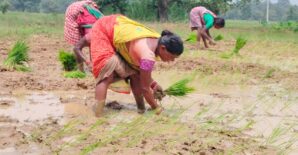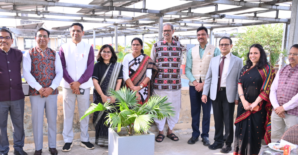
Farmer in the field at Nalanda District, Bihar. Source: (Flickr) Divya Pandey, IFPRI
Australian Centre for International Agricultural Research (ACIAR) and International Food Policy Research Institute (IFPRI) organized a two day, Regional Dialogue on Agricultural Mechanization in South Asia on July 20-21, 2017 in New Delhi, India. The focus of the regional dialogue was to work towards the four key issues related to agricultural mechanization and farmers.
Adoption and Impact: Machines are critical to the sustainable intensification of agriculture. Machines not only help increase land and labor productivity and allow intensification of agriculture, but are also essential to adoption of conservation agriculture (CA). Adoption of CA equipment is uneven even after 25 years of promotion. The adoption rates are especially low in the Eastern Gangetic Plains (EGP). What can eastern India learn from north-western India? What are the barriers to wider adoption and use of CA equipment? What is the impact of these machines on crop yields, crop economics and crop resilience? What kind of public policies, financing arrangements and business innovations can speed up mechanization?
Custom Hiring Centers: Ninety percent of farmers in South Asia access machines through informal rental markets that emerged spontaneously. Uncompetitive machine rental markets have become yet another source of rent extraction from poorer farmers. How should public finances (subsidies, incentives and credit) be deployed to ensure equitable access to machine services for all? In recent years, private companies, governments, farmer organizations and startups are also entering the rapidly growing machine rental market by setting up custom hiring centers (CHCs). Can CHCs compete with the machine owning individual farmers? What is the comparative advantage of the formal sector in machine rental markets, hitherto dominated by enterprising farmers? Can they be more efficient than the informal service providers and more effective in promoting new machines for sustainable farming? What business models of CHCs are likely to thrive in different parts of South Asia? What is the role of public policies in promoting CHCs?
Effect of Mechanization on Women and Agricultural Laborers: There are more agricultural laborers than cultivators in South Asia. How does farm mechanization affect laborers? Women perform a large share of the back-breaking work in South Asian agriculture. IFPRI data on women empowerment in agriculture index (WEAI) shows that women farmers and farm laborers enjoy much less leisure than their male counterparts. On one hand, machines reduce drudgery and free-up more time for women, but on the other hand, they can also take way income earning opportunities for women farm laborers. How does mechanization affect women? Are the effects different for women farmers and farm laborers? Researchers and grassroots organization working closely with women in farming present empirical evidence and share experience in this session.
Role of Public Policies in Promoting Mechanization: While a large share of the machines capital in South Asian agriculture has been financed largely by private investments, public policies on credit, capital subsidies, tariffs and trade for machines have a huge influence on mechanization of agriculture. Why are machine rental rates lower in Bangladesh than West Bengal or Nepal? Are tariffs and trade restrictions for infant industry protection, import substitution or revenue generation anti-poor? Do heavy capital subsidies hurt, not help, widespread adoption of sustainable technologies like solar pumps, drip irrigation and conservation agriculture? Researchers and policy makers from Bangladesh, India and Nepal will exchange notes in this session to improve existing public policies. Why agriculture is less mechanized in West Bengal than Bihar even when wage rates, crop yields and cropping intensity are higher there? What can Nepal learn from Bangladesh?



